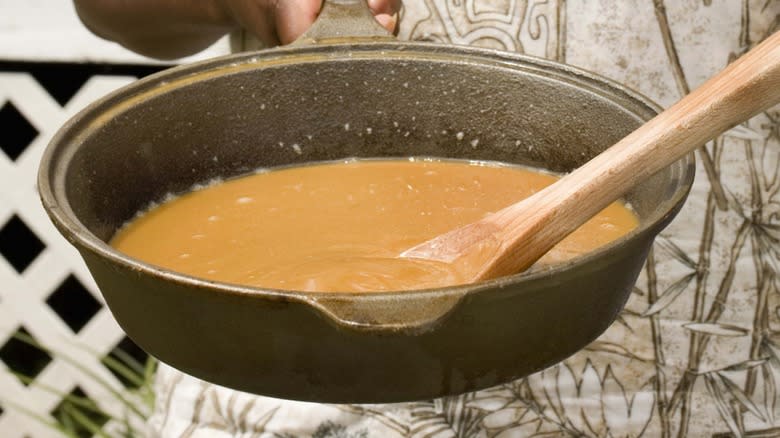The Easy Spoon Trick To Tell When Your Gravy Is Ready For Serving

Ideal gravy should be smooth, rich, and thick enough to coat your roasts, mashed potatoes, biscuits, or whatever dish you're serving it with. While making this delicious, velvety accompaniment is quite straightforward, achieving the perfect consistency can feel like a culinary tightrope walk, but fret not! There's a remarkably simple method to gauge when your gravy has hit the sweet spot, and it involves nothing more than a common kitchen spoon.
Start by cooking your gravy as you usually would. Whether you're making it from scratch with pan drippings, a roux and stock, or jazzing up a store-bought version, the spoon test works every time. As your gravy simmers, stir it now and then. After a few minutes of cooking, dip a clean spoon into your gravy. Lift it out and hold it vertically with the back of the spoon facing you. If it runs off quickly, it's too thin. If so, give it more time to simmer and thicken.
Repeatedly test your gravy every few minutes. You're looking for the gravy to coat the spoon but leave a clear line behind when you run your finger down it, with the gravy not running back together immediately. This is known as the "nappe" consistency, a French term that indicates the perfect thickness for sauces and gravies. When it has the right consistency, give your gravy a taste. Adjust the seasoning if necessary, then it's ready to serve.
Read more: The 14 Absolute Worst Mistakes You're Making With Meatloaf
What To Do If Your Gravy Fails The Spoon Test

Now, what if your gravy doesn't behave as expected? Sometimes, despite your best efforts, the gravy might end up too thick or stubbornly thin. Don't worry, these are common issues with straightforward fixes. If your gravy turns out too thick, gradually add more liquid. Depending on your recipe and preference, this can be broth, stock, or even plain water. Add the liquid in small increments, stirring continuously. After each addition, keep testing with your spoon until you reach the desired consistency.
On the other hand, if your gravy remains too runny and refuses to thicken, one common remedy is to create a slurry. Mix a small amount of cornstarch or flour with cold water until smooth, then stir this mixture into your simmering gravy. The slurry will gradually thicken the gravy as it cooks. However, be careful not to add too much at once, as this can lead to a lumpy or overly thick sauce. Always stir thoroughly and give it a few minutes to see the full thickening effect (while checking with the spoon test) before adding more. Another approach is to let the gravy simmer for a longer period. This allows the excess liquid to evaporate, naturally thickening the sauce. With both of these issues — a gravy that's too thick or too thin — the key is to adjust slowly, taste often, and use the spoon trick as your guide.
Read the original article on Tasting Table.


